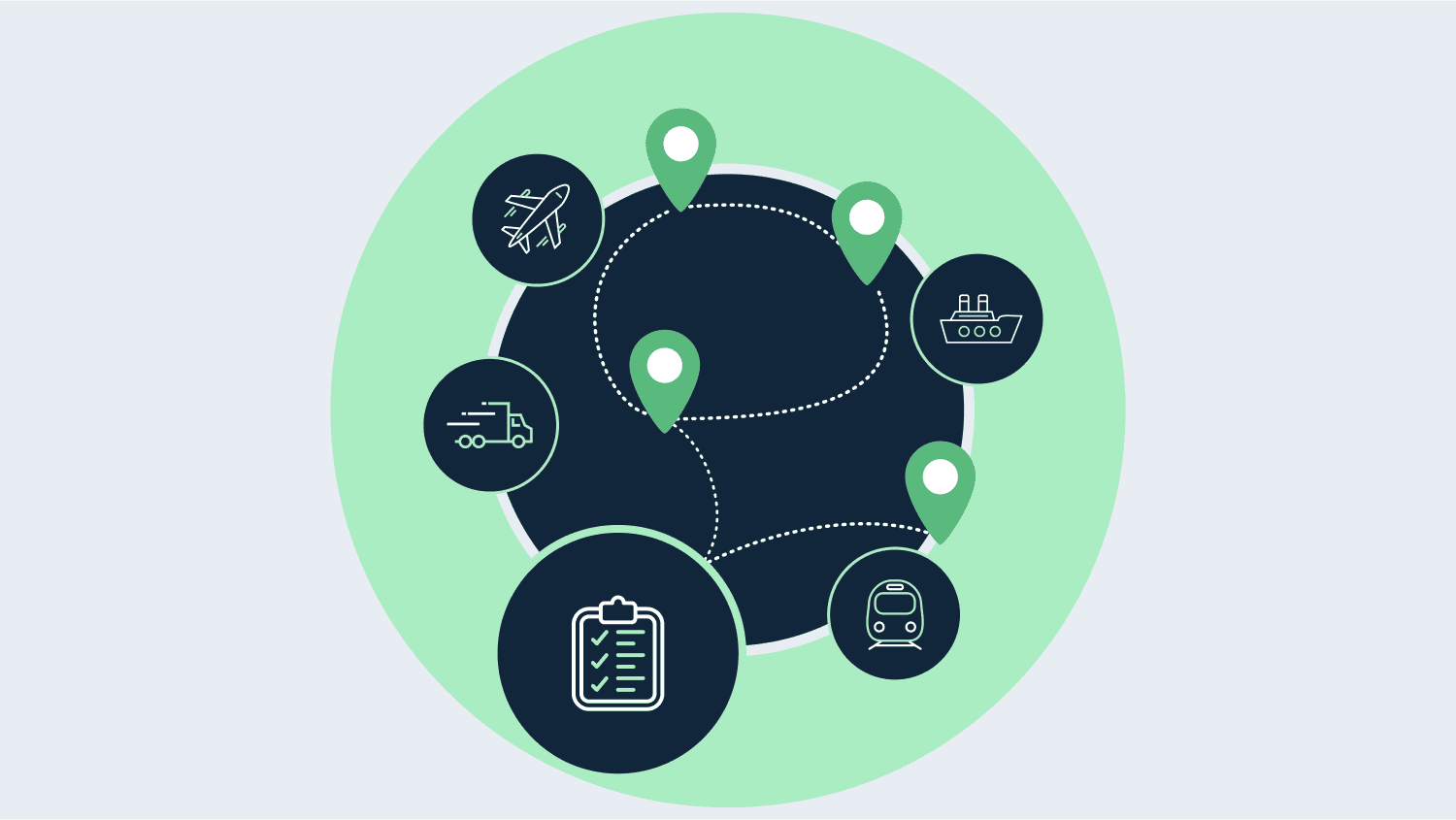How can businesses deliver packages faster while keeping costs under control? Last-mile delivery, the final step of getting a product from a local hub to the customer’s doorstep, is often the most challenging.
This complexity arises from factors like traffic delays, fuel expenses, and meeting customer expectations for same-day or next-day delivery.
Transportation route planning is the key to solving these challenges. By using smart technologies, businesses can plan the most efficient routes, reduce delivery times, and lower operational costs. It helps them avoid unnecessary stops and delays while improving customer satisfaction.
In this article, we’ll explore the major challenges companies face with last-mile delivery and the innovative solutions that can help unlock efficiency. Let’s go.
Top 10 Last-Mile Delivery Challenges and Solutions
In modern logistics, last-mile delivery plays a significant role, especially as consumer expectations continue to rise. Here are the top 10 challenges companies face with last-mile delivery and how they can overcome it.
01. High Delivery Costs
Last-mile delivery contributes to over 53% of the total shipping costs. Fuel expenses, vehicle maintenance, labor wages, and failed delivery attempts significantly impact a company’s bottom line. As companies strive to offer free or low-cost shipping, managing profitability becomes difficult.
Solution
Route optimization software minimizes travel distances, helping companies cut down on fuel consumption and vehicle wear. Partnering with third-party logistics (3PL) providers allows businesses to reduce infrastructure and labor costs.
Another approach is adopting crowdsourced delivery models, where gig economy drivers handle deliveries, reducing fixed costs. Dynamic pricing strategies based on time, location, and urgency can further help recover expenses.
02. Customer Expectations for Fast Delivery
With the rise of same-day and next-day delivery services, customers expect their orders to arrive faster than ever. Failing to meet these delivery expectations can harm customer satisfaction and loyalty, pushing them towards competitors.
Solution
Using real-time tracking systems keeps customers informed about their order status and delivery time, improving transparency. Micro-fulfillment centers, small warehouses located near urban areas, help reduce delivery time by storing high-demand products closer to customers.
Companies can also use predictive analytics to anticipate demand and pre-position inventory where it’s needed most. Offering time-definite deliveries gives customers control over when they receive their packages, reducing the pressure to deliver in tight windows.
03. Address Accuracy Issues
Incorrect or incomplete addresses lead to delivery delays, additional trips, and increased costs. Address errors can also frustrate customers and result in poor reviews, negatively impacting a company’s reputation.
Solution
Implementing address validation tools during the checkout process ensures that customer-entered addresses are accurate and complete. Geofencing technology provides drivers with precise location coordinates, especially in hard-to-find areas or multi-story buildings.
Companies can also offer address confirmation messages to customers before dispatching orders, reducing the chances of delivery to the wrong location.
04. Failed Deliveries
When customers are unavailable to receive their orders, it leads to failed delivery attempts. Each additional delivery attempt increases operational costs and wastes time, making last-mile delivery less efficient.
Solution
Businesses can implement delivery scheduling systems, allowing customers to select a convenient delivery time slot. Smart lockers placed at popular locations provide a secure pickup option, reducing failed attempts.
Some companies also use AI-driven predictive delivery to notify customers minutes before arrival, ensuring someone is available to receive the package.
05. Traffic and Weather Disruptions
Urban areas with heavy traffic congestion and unforeseen weather events, such as snow storms or floods, can delay deliveries. Sticking to planned delivery routes becomes difficult in such situations.
Solution
Using AI-powered route optimization tools, businesses can monitor real-time traffic and weather conditions, allowing drivers to take alternate routes on the fly.
Traffic management systems also help identify peak congestion times, allowing companies to adjust delivery schedules accordingly. For areas prone to weather disruptions, businesses can maintain contingency plans or use drones and e-bikes to bypass blocked roads.
06. Limited Delivery Windows
Customers expect their orders to arrive within narrow delivery windows, such as two hours. Meeting such strict timelines can lead to inefficient route planning and stress on delivery staff, resulting in operational bottlenecks.
Solution
Offering flexible delivery windows, like morning or evening slots, reduces pressure on drivers. Machine learning models can forecast delivery times more accurately, helping with better scheduling.
Predictive analytics tools can also identify patterns in customer preferences, allowing companies to group deliveries more efficiently based on similar locations or time slots.
07. Managing a Large Fleet of Drivers
Coordinating hundreds or thousands of drivers in real time can become chaotic. Without a centralized system, businesses risk delays, miscommunication, or even missed deliveries, resulting in customer dissatisfaction.
Solution
A delivery management platform provides real-time visibility into fleet operations, helping dispatchers assign tasks and monitor driver performance. GPS tracking systems offer live location updates, allowing better route planning and quick response to delays.
Businesses can also use incentive programs to reward drivers for on-time deliveries, boosting performance. Driver management apps with automated notifications help drivers stay organized and informed throughout the day.
Quick Links: How Freight Consolidators Optimize Supply Chain Network Design and Operations
08. Handling Returns and Reverse Logistics
High return rates, especially in industries like fashion and electronics, create significant challenges in last-mile logistics. Handling reverse logistics requires extra planning, staff, and transportation, which adds to operational costs.
Solution
Offering easy-to-use return portals streamlines the process for customers while allowing businesses to track returns efficiently. Partnering with consolidated return services—where multiple returns are picked up at once – helps reduce costs.
Implementing automated returns processing systems speeds up product inspections and restocking, minimizing the impact on inventory. For perishable goods, return optimization strategies ensure fast processing or disposal to prevent spoilage.
09. Environmental Impact
The growing demand for fast deliveries increases carbon emissions, with multiple delivery attempts contributing significantly to environmental damage. Companies are under pressure to adopt sustainable practices to reduce their carbon footprint.
Solution
Switching to electric vehicles (EVs), bicycles, or e-cargo bikes can significantly cut emissions in urban areas. Some companies encourage eco-conscious customers to choose green delivery options, like longer delivery windows, which allow for optimized routing.
Carbon offset programs can also help mitigate emissions by investing in reforestation or renewable energy projects.
10. Scalability Issues
As companies grow, managing larger delivery volumes while maintaining efficiency becomes a challenge. Without the right infrastructure and tools, businesses may struggle to keep up with rising demand, leading to delays and dissatisfied customers.
Solution
Cloud-based delivery management systems can handle high volumes, allowing businesses to scale operations seamlessly. These platforms automate task allocation, monitor fleet performance, and optimize routes in real time.
Companies can also implement modular logistics systems, which let them add or remove delivery hubs as demand fluctuates. Investing in AI-based forecasting tools enables businesses to predict future delivery needs and plan resources accordingly, ensuring smooth operations during peak seasons.
Read Our Case Study: Lee Kum Kee’s Journey with Sophus Yields Savings Exceeding $20 Million
Unlock Last-Mile Efficiency with Sophus X
Optimizing transportation routes is essential for managing last-mile delivery, whether a business owns its fleet or relies on third-party carriers. For companies with their own fleets, challenges like calculating transport costs, maintaining the right asset mix, and maximizing asset utilization are common hurdles.
This is where Sophus X comes in handy. We offer Transportation Routes Planning solution to help businesses optimize fleet size and asset mix and enhance multi-stop pick-up and drop-off routes.
With our advanced route optimization strategies, businesses can expect transportation cost reductions of up to 10-15%, improved service levels, and increased asset utilization.
Contact us today for a free demo of our software.










